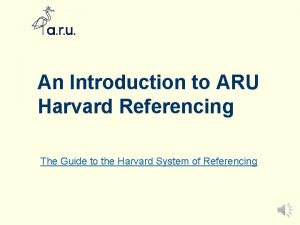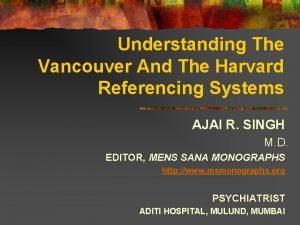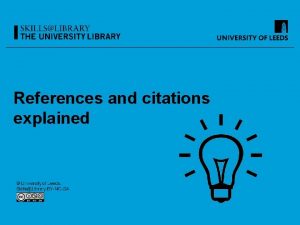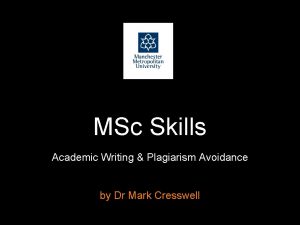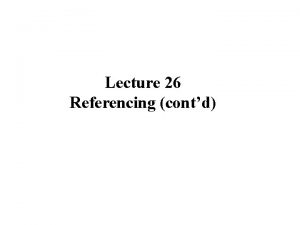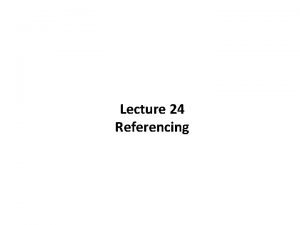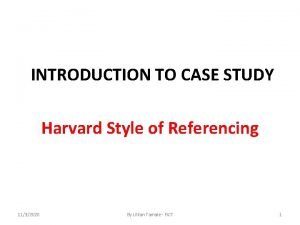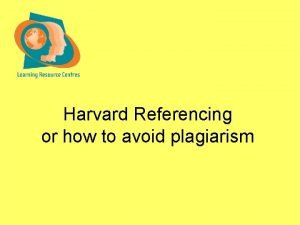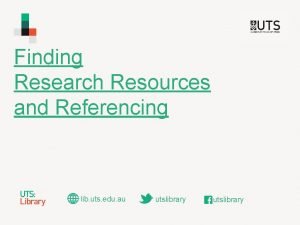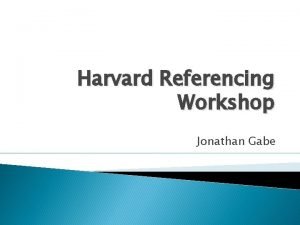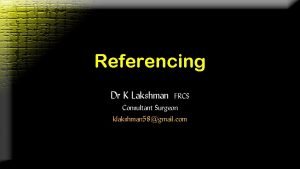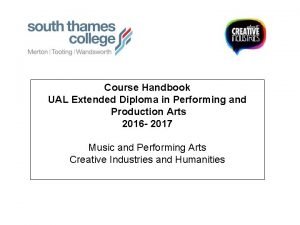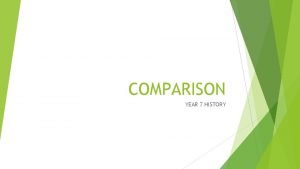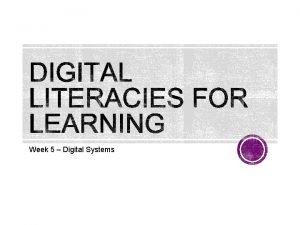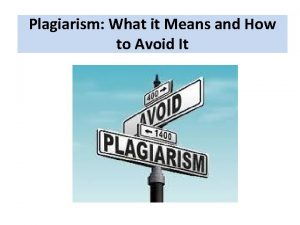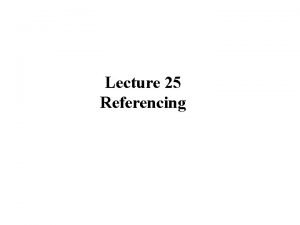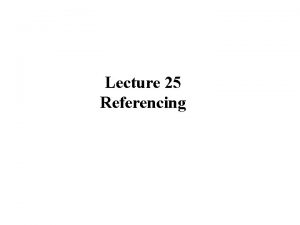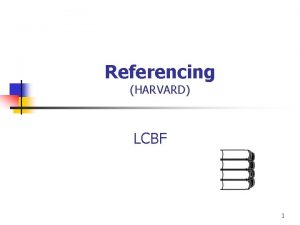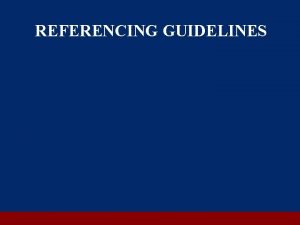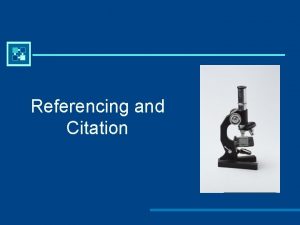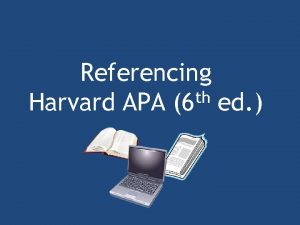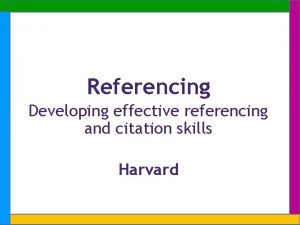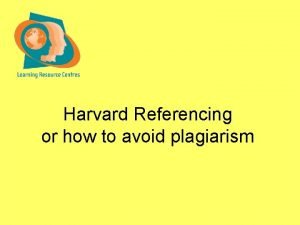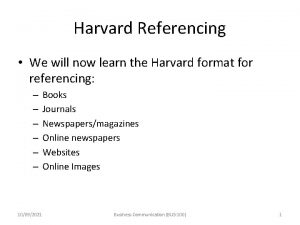An Introduction to ARU Harvard Referencing The Guide





















- Slides: 21

An Introduction to ARU Harvard Referencing The Guide to the Harvard System of Referencing

What is referencing? • Referencing is the acknowledgement of the sources of information you use in writing your work. • It appears in a particular style, depending on the referencing system you use. • This is an introduction to the ARU version of the Harvard style.

Why reference? • Good Academic Practice to acknowledge your sources • Demonstrates wider reading • Gives evidence and credibility for arguments • Shows where to find information sources • Transferable skill • Avoids Plagiarism (the academic offence of appearing to take credit for the ideas of others)

When and what to reference? When - everything except your own ideas, reflections or experiences and also common knowledge (either for the general public or within your subject area) What - not just text, but also statistics, graphs, tables, images… (everything!) So – keep a good record of all your sources

There are two parts of Harvard referencing 1. The in-text reference or citation authorship, date; 2. The reference list at the end of your assignment, arranged A-Z by author.

In-text referencing can be direct or indirect – it’s your choice Direct – the author(s) surname appear in your sentence and the date in brackets: Example Carson in an earlier paper (1970) argues that. . . on the other hand, Jones et al. (1983) has reported that in the future. . .

In text referencing - indirect Both the author(s) surname and date appear in brackets: Example An earlier paper (Carson, 1970) argues that……. on the other hand, it has been reported (Jones, et al. , 1983) that ….

In text – more than one author? If an item has one, two or three authors put in all authors’ surnames or organisation names Examples: Bloggs (2016) Department of Health (2019) Bloggs and Woods (2015) Bloggs, Woods and Smith (2014) Four or more authors: Use the first author listed on the item then et al (meaning ‘and others’ in Latin) Example: Stephenson, et al (2012)

What to include in a full reference? A five point plan 1. Who wrote it (Author) 2. When was it written (Date – year) 3. What is it called (Title) 4. What is it – Format (only if it’s online) 5. Where to find it

5 point plan – format (if online) • 1 Authorship • 2 Year • 3 What’s it called • 4 Format […] [pdf] [online] [e-book] [e-journal] • 5 Where to find it

5 point plan – where to find it • 1 Authorship • 2 Year • 3 What’s it called • 4 Format • 5 Where to find it – this bit varies, depending on the type of information being referenced

5 Where to find it Decide what type of information source you are using: • Books - Place and Publisher • Journal Articles - Volume, Issue and Pages, URL or DOI • Web Pages – Available at <……………> [Accessed DD/MM/YYYY] • PDF document – Available at <……………> [Accessed DD/MM/YYYY] PDF references are often used for reports, for example: Department of Health, 2008. Health inequalities: progress and next steps. [pdf] London: Department of Health. Available at: <http: //www. dh. gov. uk/en/Publicationsandstatistics/Publications Policy. And. Guidance/DH_085307> [Accessed 9 June 2008]. ].

Examples: Books Book Wicker, P. , 2015. Perioperative practice at a glance. 3 rd ed. Chichester: Wiley. E-book Wicker, P. , 2015. Perioperative practice at a glance. [e-book] 3 rd ed. Chichester: Wiley. Available through ARU Library website <https: //library. aru. ac. uk> [Accessed 5 October 2018].

Chapter from an edited book Chapter details author, date and chapter title Wieczorek, W. and Naish, J. , 2015. Pharmacology Book details Editors of the book Jeannette Naish and Denise Syndercombe Court, book title - Medical Sciences and publisher details In

Chapter from an edited book example Wieczorek, W. and Naish, J. , 2015. Pharmacology. In: J. Naish and D. Syndercombe Court, eds. 2015. Medical sciences. Edinburgh: Saunders Elsevier. Ch. 4.

Journal Article Journal article (print) Lean, M. E. J. , 2015. Principles of human nutrition. Medicine, 43 (2), pp. 61 -65. E-journal article Lean, M. E. J. , 2015. Principles of human nutrition. Medicine, [ejournal] 43 (2), pp. 61 -65. Available through: ARU Library website <https: //library. aru. ac. uk> [Accessed 30 October 2019]. E-journal article (alternative model with DOI) Lean, M. E. J. , 2015. Principles of human nutrition. Medicine, [ejournal] 43 (2), pp. 61 -65. https: //doi. org/10. 1016/j. mpmed. 2014. 11. 009

Webpage example Wills, D. , 2019. 10 great UK open-air theatres you can visit on public transport. [online] Available at: <https: //www. theguardian. com/travel/2019/aug/06/10 -open-air-theatres-ukvisit-public-transport-minack-cornwall> [Accessed 1 November 2019]. Note - When a web page does not have a personal author, use the organisation name.

Your Reference List – should appear at the end of your work, in alphabetical order by author Extract: Bloor, M. , Frankland, J. , Thomas, M. and Robson, K. , 2001. Focus Groups in Social Research. London: Sage. Greenbaum, T. , 1998. Handbook for Focus Groups. Thousand Oaks: Sage. Health and Safety Executive (HSE), 2018. How to organise focus groups. [pdf] Available at: <http: //www. hse. gov. uk/stress/standards/pdfs/focusgroups. pdf> [Accessed 21 June 2019]. Merton, R. , 1987. Focus interviews and focus groups: continuities and discontinuities. Public Opinion Quarterly, 51(1), pp. 550 -557. Merton, R. and Kendall P. , 2010. The focused interview. American Journal of Sociology, [e-journal] 51, pp. 541 -557. Available through: ARU Library website <library. aru. ac. uk> [Accessed 20 June 2018]. Stewart, D. W. and Shamadasani, P. N. , 2015. Focus Groups: Theory and Practice. 3 rd ed. [e-book] Available through: ARU Library website <library. aru. ac. uk> [Accessed 20 June 2018].

Harvard Guide https: //library. aru. ac. uk/referencing/harvard. htm Go to our Harvard pages for the Quick Guide and for the full Guide to find more details about referencing a wide variety of information sources

Harvard Guide For example – secondary or secondhand references:

More sources of help Information Skills Guide Good Academic Practice Guide Library FAQs and email help
 Aru referencing
Aru referencing Harvard referencing sytem
Harvard referencing sytem Rgu harvard referencing
Rgu harvard referencing Examples of vancouver referencing style
Examples of vancouver referencing style Mmu harvard
Mmu harvard Harvard referencing lecture
Harvard referencing lecture Harvard style referencing article
Harvard style referencing article Harvard style case study
Harvard style case study Bibliography harvard method
Bibliography harvard method How to harvard reference a book
How to harvard reference a book Gcu harvard referencing
Gcu harvard referencing Lib.uts.edu au
Lib.uts.edu au Maslow's hierarchy of needs harvard reference
Maslow's hierarchy of needs harvard reference How to cite a website in harvard
How to cite a website in harvard Oue harvard
Oue harvard Harvard referencing formula
Harvard referencing formula Ogrammarly
Ogrammarly Ual harvard referencing
Ual harvard referencing Narrabeen man facts
Narrabeen man facts Harvard referencing formula
Harvard referencing formula Unisa harvard referencing
Unisa harvard referencing Harvard referencing utar
Harvard referencing utar
